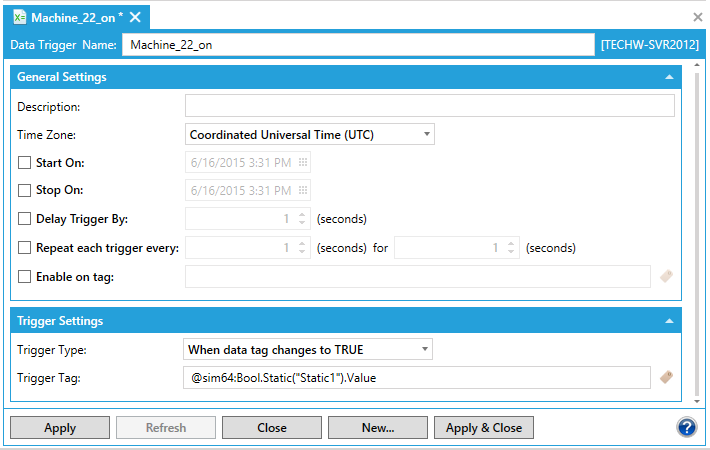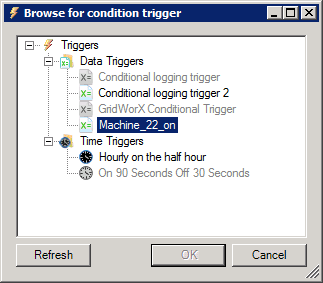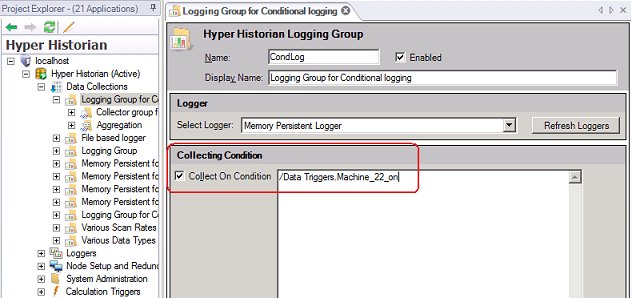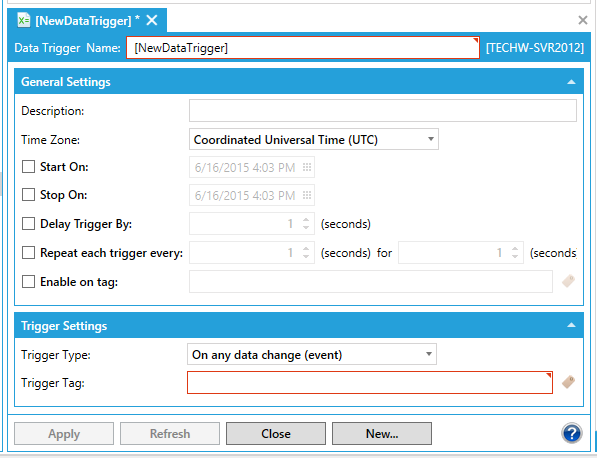Data Triggers
A Data Trigger executes an event every time a tag becomes TRUE or FALSE. That event can be sent to a data tag and used by a program to determine whether an action should proceed or not. Lets say that you want to log data in the Hyper Historian , but only when the system of interest (Machine_22) is actually running. You cou,ld create a data trigger that sets a data trigger that sets the data flag to TRUE when the system starts up. In the figure below the Machine_22_on data trigger has its value set to TRUE and has that value sent as an event to a PLC INPUTS.BIT.value tag (here a simulator).
Setting a Data Trigger Tag

With the Data Trigger defined, you can set the condition within another application such that when the data value is true, the action occurs. For Hyper Historian, the action defined would be to log to a file based on the condition that the Data Trigger is TRUE; namely when Machine_22 is on and sending values to the tag. You would set the condition in the Logging Group form's Collecting Condition section by clicking on the ellipsis [...] button in that section to open the Browse for condition trigger dialog box shown below.
Browse For Condition Dialog Box

The Data Trigger is shown in the Hyper Historian Logging Group form below. When the flag is TRUE logging will then occur.
Collecting Condition Based On Data Trigger

Data triggers are organized in a tree structure of folders and data trigger tags (items). Folders allow organization of data tags into a hierarchical tree structure.
To Create aNew Data Trigger Folder:
-
Start the Workbench, then expand your project. Next, expand the Platform Services node to show the Unified Data Manager provider. Next, expand the Triggers node.
-
Right-click the Data Triggers node in the navigation tree and select Add Folder, as shown in the figure below.
Add Folder from the Project Explorer

-OR-
Select the Data Triggers node in the Project Explorer, then click on the Add Folder button, shown below, in the Edit section of the Home ribbon in the Workbench.
Add Folder Button

-
The Data Trigger Folder properties appear beneath the Project Details section in the Workbench. In the Name text entry field, type a name for the new folder.
-
Click theApplybutton. The new folder appears under the Data Triggers tree control.
To Create a New Data Trigger Item:
-
Start the Workbench, then expand your project. Next, expand the Platform Services node to show the Unified Data Manager provider. Next, expand the Triggers node.
-
Right-click the Data Triggers node in the navigation tree (or a Data Trigger folder sub-node) and select Add Data Trigger, as shown in the figure below.
Add Data Trigger from the Project Explorer

-OR-
Select the Data Triggers node in the Project Explorer (or a Data Trigger folder sub-node), then click on the Add Data Trigger button, shown below, in the Edit section of the Home ribbon in the Workbench.
Add Data Trigger Button

-
This opens the Data Trigger properties window, shown below, beneath the Project Details section in the Workbench. Enter a name in the Data Trigger Name text entry field.
Data Trigger Properties

-
In the General Settings section of the window, in the Description field, you can type a description for the new time trigger (optional).
-
Time Zone - You can select an option to use the Local Server Time zone of your system or switch to UTC, the Coordinated Universal Time often referred to as Greenwich Mean Time or GMT.
-
Start On - The Start On time begins the period during which the data trigger remains active and changes state. The condition in place at the end of the period remains in effect after the condition period ends.
-
Stop On - The Stop On time ends the period during which the data trigger remains active and changes state. The condition in place at the end of the period remains in effect after the condition period ends.
-
Delay Trigger By - The Delay trigger by time interval is a one time setting that moves the starting date and time by the number of days, hours, minutes, and seconds that you set in these combo boxes.
-
Repeat each trigger every - Click this checkbox if you wish to repeat the trigger. You can then set the time intervals.
-
Enable on tag - Specify a tag on which to enable the recurrence condition. Clicking the
 button allows you to select a tag from the Unified Data Browser. The trigger will be disabled if Enable Tag has a value of 0, FALSE, or BadQuality).
button allows you to select a tag from the Unified Data Browser. The trigger will be disabled if Enable Tag has a value of 0, FALSE, or BadQuality). -
In the Trigger Settings section, select the Trigger Type in the Trigger Type drop-down list. Select from On any data change (event), When data tag changes to FALSE, When data tag changes to TRUE, When data tag is FALSE, and When data tag is TRUE.
-
Set the Trigger Tagg in the text entry box, either by directly typing it or by clicking on the
 button and selecting it from the Unified Data Browser.
button and selecting it from the Unified Data Browser. -
Click the Apply button. The new time trigger item appears under the Data Triggers node or in the folder that you clicked on in Step 1.
See also: